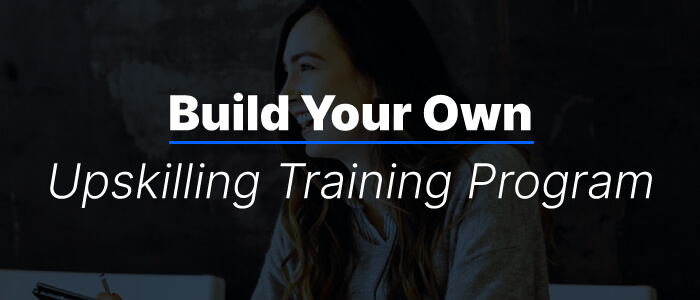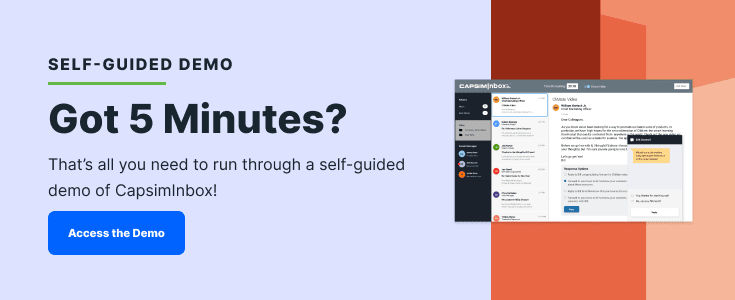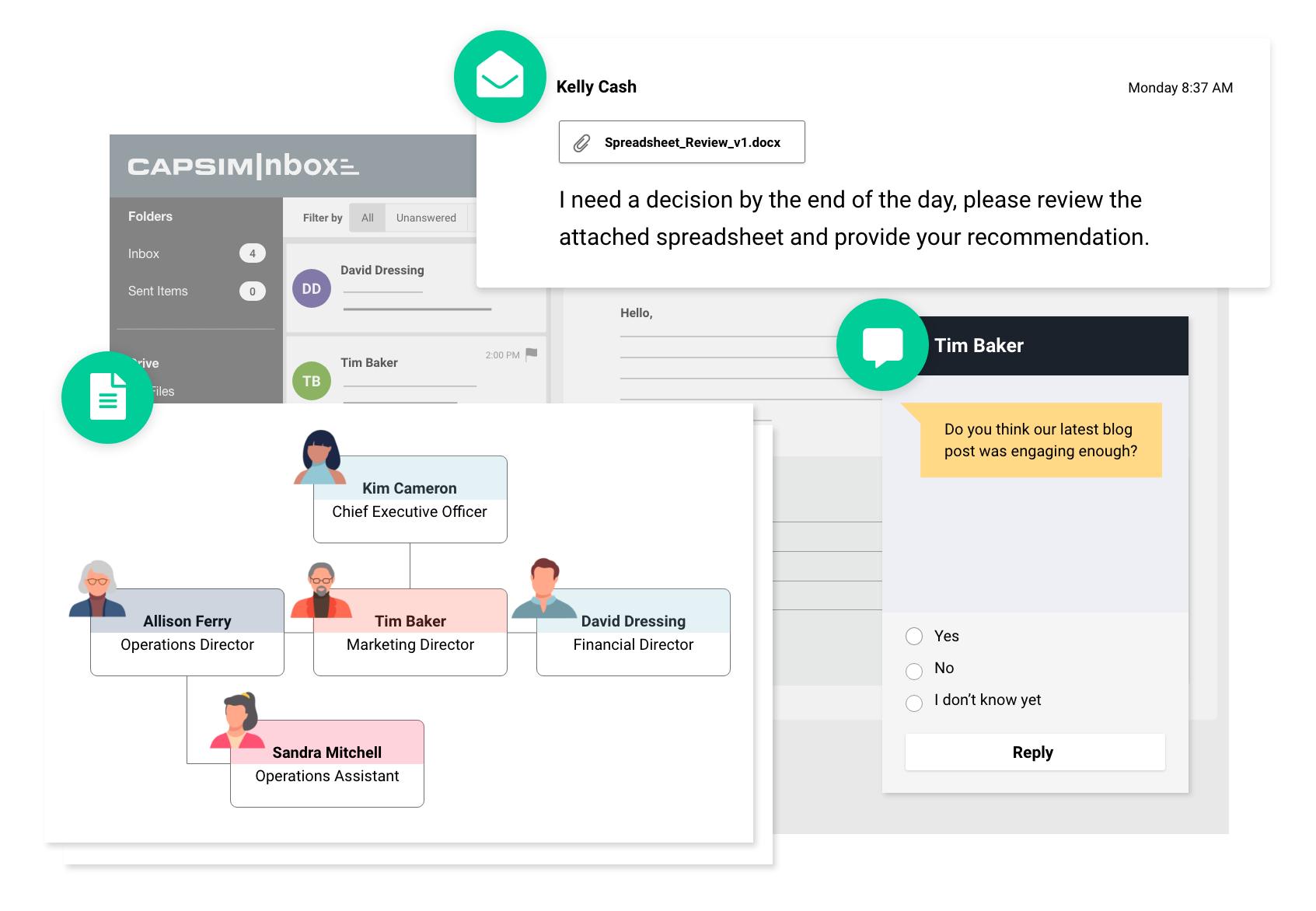How to Build Your Own Upskilling Training Program
January 28, 2022

Is your current workforce equipped to drive your company’s success in the next three to five years? With the rapid pace of innovation and change in the world of work, Gartner found that nearly one in three skills needed for a job in 2018 won’t be needed in 2022.
The upshot is that your workforce’s collective skills need to be upgraded over time. This is a mission-critical responsibility for corporate learning and development teams, known as upskilling.
So, how do you upskill your employees the right way? How do you create an upskilling training program that will power your company forward and produce five-star talent? Read on to find out.
Building Your Upskilling Training Program from Scratch in 5 Steps
To establish the best way to build an upskilling training program, we first need to establish some crucial baseline knowledge. First, what do we mean by “upskilling?”
Upskilling refers to the process of teaching an employee new or more advanced skills. The important thing to remember about upskilling is that you are not substantially changing the employee’s job function. Upskilling provides employees with the tools and knowledge needed to perform their job duties more effectively, efficiently, or in a more modern manner.
As technology advances and the economy shifts, the skills employees need to be successful change. These changes result in a disconnect between your workers’ skills and your organization’s goals, known as a talent gap. Eighty-seven percent of surveyed employers are either currently facing a talent gap or expect to confront such a gap in the next three to five years.
Employers looking to confront these talent gaps are left with two options: upskill their workforce, or hire new employees. Upskilling and training employees can seem costly at first glance, but recruiting and training a new employee is far from inexpensive. On the contrary, the U.C. Berkeley Institute for Research on Labor and Employment estimates that it costs upwards of $4,000 beyond salary and wages to hire and train one new employee.
Unsurprisingly, many employers choose to evolve their workers, building a resilient, flexible, and adaptable workforce.
Related Read: Seven Steps to Retain Your Employees [that aren’t obvious]
Regardless of your field or industry, the consequences of continuing with “business as usual” without implementing an upskilling program may be severe. As the market and technology evolve, many skills will become obsolete. Workers relying on those skills to succeed in their jobs will become unproductive at best and dissatisfied and disengaged at worst. IBM research indicates that employees who feel stagnated in their jobs or fear their position is becoming obsolete are 12 times more likely to leave.
In short, you need an upskilling training program for your business to succeed now and in the future. We will provide you with a simple, five-step guide to devising and implementing an incredible upskilling training program in your organization.
Step 1: Understand the Direction Your Company is Heading
Before you can begin planning your upskilling training program, you will first need to establish some baselines. Start by determining your company’s five-year plan. Discuss large-scale goals with key stakeholders in your organization to establish your company’s ideal, short-term future.
When determining this plan, consider your organization’s goals and objectives. What does success look like for your company?
Setting this desired endpoint is critical. After all, you can’t build a road if you are unsure of where you’re trying to go. For example, suppose your organization plans to reduce overhead costs by shifting to a largely remote workforce and closing one of your physical locations. In that case, this desired change will impact your upskilling needs.
Step 2: Determine the Required Personnel and Skills Needed
With your organization’s goals in mind, you can now examine the human capital and skills you will need to achieve those goals.
Do your goals require you to implement a new technical solution? If so, you may need to bring in additional personnel. Consider the skills, experience, or education an employee would need to be successful in that role.
Determining the skills necessary to achieve your organization’s goals gives you a preliminary view of the required competencies for your company to meet its definition of success in the coming years.
To return to our earlier example, if you plan to shift a portion of your workforce to a remote work schedule, you will likely need to implement new technologies. You are likely considering video conferencing applications, task management programs, remote desktop applications, and more. To succeed in their roles, employees will need knowledge of these applications and crucial soft skills that allow them to work and collaborate well in a remote work environment. What’s more, you may need additional personnel to support those technologies internally.
Step 3: Identify Current Employees Skill Levels and Skill Gaps
Armed with your organizational goals and a working knowledge of the skills and personnel you’ll need to achieve them, you are ready to move on to the third step in developing your upskilling training program: Identifying the talent gaps in your organization.
You will want to begin by conducting a skills gap analysis for each of your current employees. There are several methods you can use to conduct a skills gap analysis:
- Employee Reviews:
Managers or supervisors conduct performance reviews with each employee in a review-based skills gap analysis. Through interviewing the employee and reviewing their performance on various KPIs, management will determine the skill gaps of each employee. This method can be time-intensive and subjective. - Self-Evaluation:
Self-evaluative skills gap analyses are just what they sound like: your employees will determine their own skill gaps based on their job knowledge and understanding of company goals. An important downside of this method is that employees may misrepresent their skills to appear more valuable, often making self-evaluative skills gap analyses inaccurate. - On-the-Job Observation:
Managers or HR professionals can also observe each worker on the job as a means of skills gap analysis. This method of skills gap analysis is less subjective than employee reviews or self-evaluation, but it is by far the most resource-intensive method of skills gap analysis.
- Simulations:
You can provide employees with a real-world situation in a controlled, measurable environment using a simulation. This method gives you reportable data considering each employee’s demonstrated skills. You can either use off-the-shelf simulations or create custom-built simulations if your needs are more specific.
Your skills gap analyses will provide you with a baseline for each employee. This knowledge will enable you to create an individual development plan for each employee. Additionally, you can review the data from your skills gap analyses to identify good candidates in your current workforce for upskilling any new roles you determined necessary in step 2. You will also have a clearer picture of which roles you will need to hire new employees to fill.
In our remote work example, your skills gap analysis may reveal a current employee with strong technical support skills who may be a great candidate for the functional administrator of your new task management software. Alternatively, you may discover weaknesses in your team’s remote presentation or communication skills. Both of these cases would be excellent opportunities for upskilling.
Step 4: Determine the Success Metrics and KPIs for Your Upskilling Program
How do you determine the success of any initiative? You need to set the bar before beginning. Your upskilling training program will be no different.
Determine success metrics and KPIs for your program based on the roles and skills you identified in the earlier steps of building your upskilling training program. These metrics will not only be useful in determining the success of your training program as a whole but will also provide employees with a framework for their success in the program.
Related Read: The What, When, Why and How of Program Evaluation
Some examples of metrics you may want to consider are job performance measures, knowledge retention, or transfer of learning. The metrics you choose to focus on will impact the tools you want to use for your program. For example, if you are dedicated to succeeding in knowledge retention, you will want to choose a “stickier” training method for your upskilling program, like simulation-based learning.
Tracking success metrics helps ensure your employees are on track to succeed in the program while also providing valuable data to your executive and leadership teams. After all, upskilling is an investment in your workforce, and your organization’s leadership will value data that indicates a promise of return on investment.
Step 5: Start Building Your Upskilling Training Program
In steps one through four, you have gathered all the variables for our upskilling equation: The roles and skills required to reach your company’s goals, your current workforce’s skills (and skill gaps), and your method of determining success in upskilling. Now, you are ready to build your upskilling training program.
Start by meeting with employees at every level of your organization. This measure will help you align your staff with your organization's goals. Once everyone is on the same page about the improvements, determine your training methods.
You have many options for the tools you can use to upskill your workforce. You can bring in speakers for presentations, hold seminars, host “lunch and learns,” provide webinars or enjoy the advantages of simulation-based learning. Our recommendation is to use a combination of these different tools to achieve maximum results.
For example, you may want to begin your training with a presentation or a “lunch and learn” to establish base knowledge, then follow up with a simulation to ensure the knowledge has been transferred and retained.
Another important step is to set up a regular schedule or cadence for upskilling sessions. There are only so many hours in a workday, and your employees still have their regular job duties to accomplish. Causing too much interruption in their workday can cause frustration and lead to disengagement. You may want to explore more modular learning methods like microlearning. Regardless of your training methods, your sessions should be consistent. This consistency will help you build and keep momentum.
You’ll want to follow up each step of your upskilling training program with a debriefing session. This practice will allow you to see if employees retain the knowledge they gained from your training efforts. Did their behavior change? What growth can you see in your employees at each stage?
Related Read: Debriefing in Simulation-Based Learning is Critical. Here's Why.
The last note here is to ensure that you take steps to map your upskilling efforts to the goals you identified. Maintaining a link between your efforts and the organization’s goals will not only ensure that you stay on track and aligned with the company’s needs; it will also help you to maintain buy-in from leadership.
Your Next Steps for Building a Successful Upskilling Training Program
You are ready to build your own upskilling training program with these steps in hand. Now, all that is left to do is choose your tool.
The current market has many options for corporate training resources. If you are looking for a tool to help you with knowledge retention, knowledge application, and reinforcement, simulations are your best option.
Simulations enable your workforce to test out their new skills in a controlled, measurable environment that mimics the real world. You can use simulations at every step in your upskilling program, from the initial skills gap assessment to learning modules to on-the-job progress checks after your training program is complete. An additional benefit of simulations is their unique ability to develop and measure soft skills.
CapsimInbox offers many different simulation training options, from off-the-shelf simulations to custom-built options. To see how CapsimInbox can make your upskilling efforts more effective, check out our business use cases to see how other companies are using our simulations.





.png?width=80&name=1-questions%20(1).png)